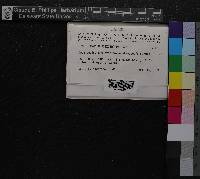Sphagnum fitzgeraldii
|
|
|
|
Family: Sphagnaceae
|
Plants small and weak-stemmed, flaccid and ± plumose when submerged to (more frequently) sprawling in thin mats; capitulum ± compact and with a strong terminal bud; pale green to greenish white. Stem pale green; superficial cortex of 1-2 layers of thin-walled and well differentiated cells. Stem leaves large, ovate to oblong-ovate, ca. 2 mm, more or less spreading; apex rounded and serrulate; hyaline cells fibrillose and often 1-septate, convex surface generally aporose, concave surface with 1-several round pores per cell in ends and angles. Branches unranked to slightly 5-ranked, often short and blunt at distal end. Branch fascicles with 1-2 spreading and 0-1 pendent branches. Branch stems green, with cortex enlarged with conspicuous retort cells. Branch leaves ovate to oblong-quadrate, 1.2-2.5 mm, not undulate or recurved when dry, strongly toothed across apex and serrulate on margins; hyaline cells with to 4 small round ringed pores at cell ends on convex surface, small round wall thinnings in the cell ends and angles on the concave surface; chlorophyllous cells trapezoidal in transverse section, more broadly exposed on the convex surface. Sexual condition monoicous. Spores 38-48 µm; both surfaces covered with fine to moderately coarse papillae; proximal laesura less than 0.4 spore radius. Commonly in prostrate mats on damp sand, often in recently burned or cleared areas, also occasionally floating in ditches; low elevations; Ala., Fla., Ga., La., Miss., N.C., S.C., Va. Sporophytes of Sphagnum fitzgeraldii are common, being immersed or exserted. This species is found largely on the Atlantic coastal plain. The wide truncate branch leaves easily distinguish it in most situations. Floating plants are not as quickly identified but can be distinguished from other species of sect. Cuspidata by the branch leaves wider than those of similar species.
|



